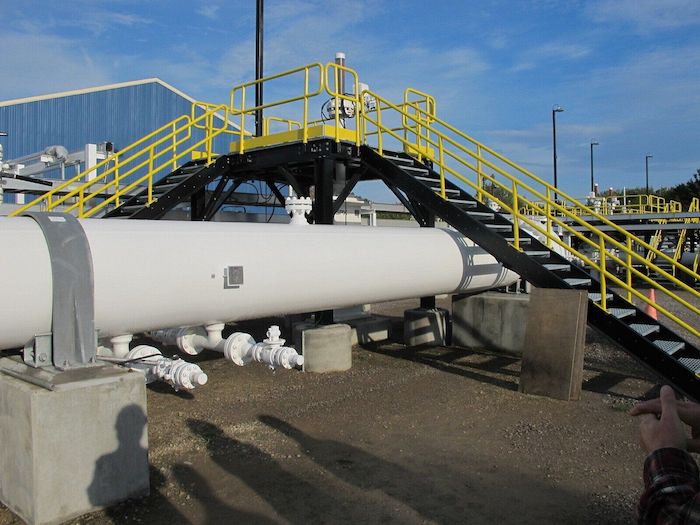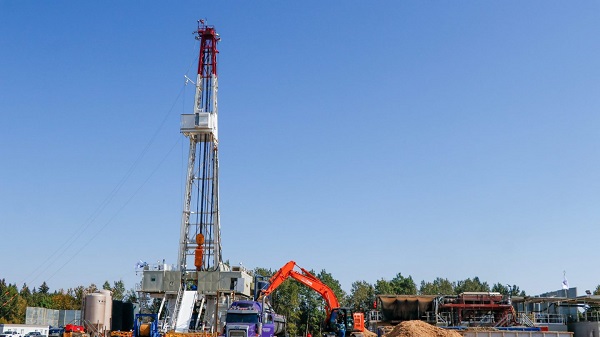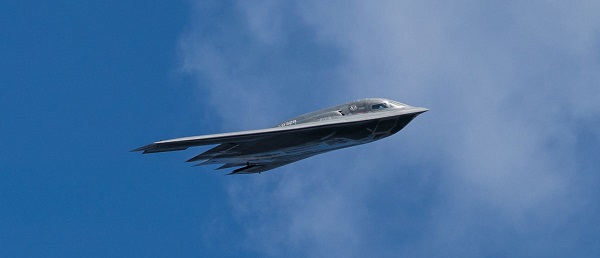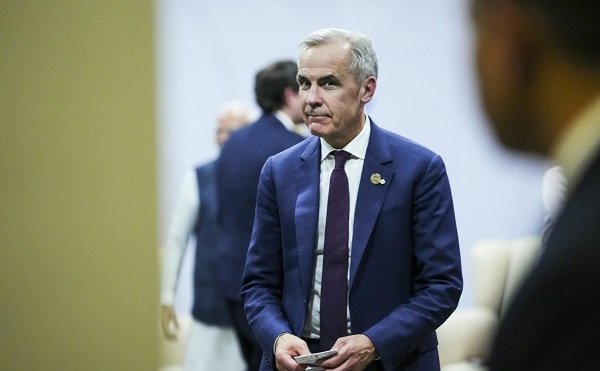Energy
Enbridge punches back on Line 5 challenge: ‘Nothing but counter-factual speculation’

This photo taken in October 2016 shows an aboveground section of Enbridge’s Line 5 at the Mackinaw City, Mich., pump station. The Bad River Band of the Lake Superior Chippewa wants a federal judge in Wisconsin to order the pipeline closed, fearing a rupture on its territory due to spring flooding. THE CANADIAN PRESS/AP-John Flesher
By James McCarten in Washington
Michigan joined the Line 5 legal fray unfolding just across state lines Wednesday as lawyers for Enbridge Inc. and an Indigenous band prepared to square off over whether the controversial cross-border pipeline should be shut down.
The stage is set for oral arguments Thursday in the Wisconsin capital of Madison as a federal judge contemplates whether to order the taps turned off and the pipeline’s contents purged to forestall a watershed-fouling rupture.
That hearing will now also include lawyers fighting a similar legal battle with Enbridge in Michigan, where Attorney General Dana Nessel has so far been thwarted in her three-year campaign to seal off Line 5 for good.
The Bad River Band of the Lake Superior Chippewa, through whose northern Wisconsin territory the line runs, has filed a motion arguing that spring flooding along the riverbanks has rendered the risk of a breach too great to ignore.
Nonsense, Enbridge argues back in an opposition brief that takes direct aim at the band’s claims of a looming environmental emergency, as well as the “drastic remedy” its lawyers are requesting.
“Despite having to prove both liability and grounds for an injunction, the band has done neither. The motion must therefore be denied,” the brief reads, describing their argument as “alarmist” and “counterfactual speculation.”
“No release of oil is ‘ready to take place,’ ‘happening soon,’ or ‘real and immediate.'”
The 50-page filing includes among its exhibits an email exchange between Enbridge and the band’s natural resources officials to support its argument that the band has been unwilling to allow the company to do any remedial work.
“This court should contrast the evidence before it of Enbridge’s persistent efforts and overtures to reach a solution … with the band’s refusal to meaningfully engage or act.”
Even if the risk was high, shutting down the pipeline would not be the appropriate remedy, Enbridge says, pointing to a court-ordered contingency plan that spells out the steps it would take if the threat were indeed urgent.
“Enbridge will pre-emptively purge and shut down the line well in advance of any potential rupture,” the brief says, adding that the area remains under constant 24-hour video surveillance.
“Any flooding and erosion has not, and would not, catch Enbridge by surprise.”
Heavy flooding that began in early April washed away significant portions of the riverbank where Line 5 intersects the Bad River, a meandering, 120-kilometre course that feeds Lake Superior and a complex network of ecologically delicate wetlands.
The band has been in court with Enbridge since 2019 in an effort to compel the pipeline’s owner and operator to reroute Line 5 around its traditional territory — something the company has already agreed to do.
But the flooding has turned a theoretical risk into a very real one, the band argues, and it wants the pipeline closed off immediately to prevent catastrophe.
Line 5 meets the river just past a location the court has come to know as the “meander,” where the riverbed snakes back and forth multiple times, separated from itself only by several metres of forest and the pipeline itself.
At four locations, the river was less than 4.6 metres from the pipeline — just 3.4 metres in one particular spot — and the erosion has only continued.
Michigan, led by Nessel, has been arguing since 2019 that it’s only a matter of time before Line 5 leaks into the Straits of Mackinac, the ecologically delicate waterway where it crosses the Great Lakes.
“The alarming erosion at the Bad River meander poses an imminent threat of irreparable harm to Lake Superior which far outweighs the risk of impacts associated with a shutdown of the Line 5 pipeline,” she argues in her brief.
“Without judicial intervention, it is likely that this irreparable harm will be inflicted not only on the band, but also on Michigan, its residents, and its natural resources.”
The economic arguments against shutting down the pipeline — which carries 540,000 barrels of oil and natural gas liquids daily across Wisconsin and Michigan to refineries in Sarnia, Ont. — are by now well-known.
Its proponents, including the federal government, say a shutdown would cause major economic disruption across Alberta, Saskatchewan and the U.S. Midwest, where Line 5 provides feedstock to refineries in Michigan, Ohio and Pennsylvania.
It also supplies key refineries in Ontario and Quebec, and is vital to the production of jet fuel for major airports on both sides of the Canada-U.S. border, including Detroit Metropolitan and Pearson International in Toronto.
“The implications (of a shutdown) are significant — not only to Pearson airport, not only to the Detroit airport, but to our mutual economies,” Transport Minister Omar Alghabra said Wednesday on Parliament Hill.
Talks about possible contingency plans have been taking place, he added, though he hinted at something Enbridge and pipeline experts have been saying for years: there are no real alternatives.
“There’s been ongoing discussion,” Alghabra said. “But I can tell you that our focus is making sure that Line 5 continues operations.”
That was the idea behind a lengthy statement issued Tuesday by the Canadian Embassy, which warned of severe economic consequences as well as potential ramifications for bilateral relations were the line to close.
“The energy security of both Canada and the United States would be directly impacted by a Line 5 closure,” the statement said. Some 33,000 U.S. jobs and US$20 billion in economic activity would be at stake, it added.
“At a time of heightened concern over energy security and supply, including during the energy transition, maintaining and protecting existing infrastructure should be a top priority.”
Talks have been ongoing for months under the terms of a 1977 pipelines treaty between the two countries that effectively prohibits either country from unilaterally closing off the flow of hydrocarbons.
Nonetheless, the embassy’s statement and the Enbridge brief tacitly acknowledge that the prospect of a shutdown order is very real.
In Enbridge’s case, the brief pre-emptively asks the judge to grant a stay of 30 days, should an injunction be ordered, to give lawyers time to mount an appeal.
And if “this specific, temporary flood situation” results in a shutdown, the embassy says, Canada expects the U.S. to comply with the treaty, “including the expeditious restoration of normal pipeline operations.”
This report by The Canadian Press was first published May 17, 2023.
Business
Canada’s future prosperity runs through the northwest coast

Prince Rupert Port Authority CEO Shaun Stevenson. Photo courtesy Prince Rupert Port Authority
From the Canadian Energy Centre
A strategic gateway to the world
Tucked into the north coast of B.C. is the deepest natural harbour in North America and the port with the shortest travel times to Asia.
With growing capacity for exports including agricultural products, lumber, plastic pellets, propane and butane, it’s no wonder the Port of Prince Rupert often comes up as a potential new global gateway for oil from Alberta, said CEO Shaun Stevenson.
Thanks to its location and natural advantages, the port can efficiently move a wide range of commodities, he said.
That could include oil, if not for the federal tanker ban in northern B.C.’s coastal waters.
The Port of Prince Rupert on the north coast of British Columbia. Photo courtesy Prince Rupert Port Authority
“Notwithstanding the moratorium that was put in place, when you look at the attributes of the Port of Prince Rupert, there’s arguably no safer place in Canada to do it,” Stevenson said.
“I think that speaks to the need to build trust and confidence that it can be done safely, with protection of environmental risks. You can’t talk about the economic opportunity before you address safety and environmental protection.”
Safe Transit at Prince Rupert
About a 16-hour drive from Vancouver, the Port of Prince Rupert’s terminals are one to two sailing days closer to Asia than other West Coast ports.
The entrance to the inner harbour is wider than the length of three Canadian football fields.
The water is 35 metres deep — about the height of a 10-storey building — compared to 22 metres at Los Angeles and 16 metres at Seattle.
Shipmasters spend two hours navigating into the port with local pilot guides, compared to four hours at Vancouver and eight at Seattle.
“We’ve got wide open, very simple shipping lanes. It’s not moving through complex navigational channels into the site,” Stevenson said.
A Port on the Rise
The Prince Rupert Port Authority says it has entered a new era of expansion, strengthening Canada’s economic security.
The port estimates it anchors about $60 billion of Canada’s annual global trade today. Even without adding oil exports, Stevenson said that figure could grow to $100 billion.
“We need better access to the huge and growing Asian market,” said Heather Exner-Pirot, director of energy, natural resources and environment at the Macdonald-Laurier Institute.
“Prince Rupert seems purpose-built for that.”
Roughly $3 billion in new infrastructure is already taking shape, including the $750 million rail-to-container CANXPORT transloading complex for bulk commodities like specialty agricultural products, lumber and plastic pellets.

The Ridley Island Propane Export Terminal, Canada’s first marine propane export terminal, started shipping in May 2019. Photo courtesy AltaGas Ltd.
Canadian Propane Goes Global
A centrepiece of new development is the $1.35-billion Ridley Energy Export Facility — the port’s third propane terminal since 2019.
“Prince Rupert is already emerging as a globally significant gateway for propane exports to Asia,” Exner-Pirot said.
Thanks to shipments from Prince Rupert, Canadian propane – primarily from Alberta – has gone global, no longer confined to U.S. markets.
More than 45 per cent of Canada’s propane exports now reach destinations outside the United States, according to the Canada Energy Regulator.
“Twenty-five per cent of Japan’s propane imports come through Prince Rupert, and just shy of 15 per cent of Korea’s imports. It’s created a lift on every barrel produced in Western Canada,” Stevenson said.
“When we look at natural gas liquids, propane and butane, we think there’s an opportunity for Canada via Prince Rupert becoming the trading benchmark for the Asia-Pacific region.”
That would give Canadian production an enduring competitive advantage when serving key markets in Asia, he said.
Deep Connection to Alberta
The Port of Prince Rupert has been a key export hub for Alberta commodities for more than four decades.
Through the Alberta Heritage Savings Trust Fund, the province invested $134 million — roughly half the total cost — to build the Prince Rupert Grain Terminal, which opened in 1985.
The largest grain terminal on the West Coast, it primarily handles wheat, barley, and canola from the prairies.
Today, the connection to Alberta remains strong.
In 2022, $3.8 billion worth of Alberta exports — mainly propane, agricultural products and wood pulp — were shipped through the Port of Prince Rupert, according to the province’s Ministry of Transportation and Economic Corridors.
In 2024, Alberta awarded a $250,000 grant to the Prince Rupert Port Authority to lead discussions on expanding transportation links with the province’s Industrial Heartland region near Edmonton.
Handling Some of the World’s Biggest Vessels
The Port of Prince Rupert could safely handle oil tankers, including Very Large Crude Carriers (VLCCs), Stevenson said.
“We would have the capacity both in water depth and access and egress to the port that could handle Aframax, Suezmax and even VLCCs,” he said.
“We don’t have terminal capacity to handle oil at this point, but there’s certainly terminal capacities within the port complex that could be either expanded or diversified in their capability.”
Market Access Lessons From TMX
Like propane, Canada’s oil exports have gained traction in Asia, thanks to the expanded Trans Mountain pipeline and the Westridge Marine Terminal near Vancouver — about 1,600 kilometres south of Prince Rupert, where there is no oil tanker ban.
The Trans Mountain expansion project included the largest expansion of ocean oil spill response in Canadian history, doubling capacity of the West Coast Marine Response Corporation.

The K.J. Gardner is the largest-ever spill response vessel in Canada. Photo courtesy Western Canada Marine Response Corporation
The Canada Energy Regulator (CER) reports that Canadian oil exports to Asia more than tripled after the expanded pipeline and terminal went into service in May 2024.
As a result, the price for Canadian oil has gone up.
The gap between Western Canadian Select (WCS) and West Texas Intermediate (WTI) has narrowed to about $12 per barrel this year, compared to $19 per barrel in 2023, according to GLJ Petroleum Consultants.
Each additional dollar earned per barrel adds about $280 million in annual government royalties and tax revenues, according to economist Peter Tertzakian.
The Road Ahead
There are likely several potential sites for a new West Coast oil terminal, Stevenson said.
“A pipeline is going to find its way to tidewater based upon the safest and most efficient route,” he said.
“The terminal part is relatively straightforward, whether it’s in Prince Rupert or somewhere else.”
Under Canada’s Marine Act, the Port of Prince Rupert’s mandate is to enable trade, Stevenson said.
“If Canada’s trade objectives include moving oil off the West Coast, we’re here to enable it, presuming that the project has a mandate,” he said.
“If we see the basis of a project like this, we would ensure that it’s done to the best possible standard.”
Alberta
Emissions Reduction Alberta offering financial boost for the next transformative drilling idea

From the Canadian Energy Centre
$35-million Alberta challenge targets next-gen drilling opportunities
‘All transformative ideas are really eligible’
Forget the old image of a straight vertical oil and gas well.
In Western Canada, engineers now steer wells for kilometres underground with remarkable precision, tapping vast energy resources from a single spot on the surface.
The sector is continually evolving as operators pursue next-generation drilling technologies that lower costs while opening new opportunities and reducing environmental impacts.
But many promising innovations never reach the market because of high development costs and limited opportunities for real-world testing, according to Emissions Reduction Alberta (ERA).
That’s why ERA is launching the Drilling Technology Challenge, which will invest up to $35 million to advance new drilling and subsurface technologies.
“The focus isn’t just on drilling, it’s about building our future economy, helping reduce emissions, creating new industries and making sure we remain a responsible leader in energy development for decades to come,” said ERA CEO Justin Riemer.
And it’s not just about oil and gas. ERA says emerging technologies can unlock new resource opportunities such as geothermal energy, deep geological CO₂ storage and critical minerals extraction.
“Alberta’s wealth comes from our natural resources, most of which are extracted through drilling and other subsurface technologies,” said Gurpreet Lail, CEO of Enserva, which represents energy service companies.
ERA funding for the challenge will range from $250,000 to $8 million per project.
Eligible technologies include advanced drilling systems, downhole tools and sensors; AI-enabled automation and optimization; low-impact rigs and fluids; geothermal and critical mineral drilling applications; and supporting infrastructure like mobile labs and simulation platforms.
“All transformative ideas are really eligible for this call,” Riemer said, noting that AI-based technologies are likely to play a growing role.
“I think what we’re seeing is that the wells of the future are going to be guided by smart sensors and real-time data. You’re going to have a lot of AI-driven controls that help operators make instant decisions and avoid problems.”
Applications for the Drilling Technology Challenge close January 29, 2026.
-

 Artificial Intelligence2 days ago
Artificial Intelligence2 days ago‘Trouble in Toyland’ report sounds alarm on AI toys
-

 Business13 hours ago
Business13 hours agoRecent price declines don’t solve Toronto’s housing affordability crisis
-

 Bruce Dowbiggin1 day ago
Bruce Dowbiggin1 day agoSometimes An Ingrate Nation Pt. 2: The Great One Makes His Choice
-

 National1 day ago
National1 day agoMedia bound to pay the price for selling their freedom to (selectively) offend
-

 Daily Caller12 hours ago
Daily Caller12 hours agoTech Mogul Gives $6 Billion To 25 Million Kids To Boost Trump Investment Accounts
-

 C2C Journal1 day ago
C2C Journal1 day agoLearning the Truth about “Children’s Graves” and Residential Schools is More Important than Ever
-

 Business1 day ago
Business1 day agoWhy Isn’t There a Cure for Alzheimer’s Disease?
-

 armed forces1 day ago
armed forces1 day agoGlobal Military Industrial Complex Has Never Had It So Good, New Report Finds











